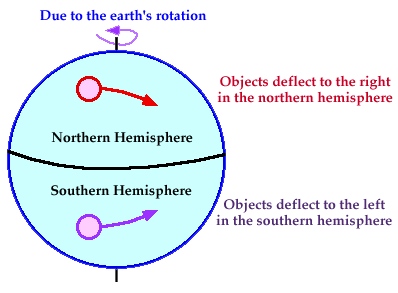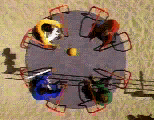Once air has been set in motion by the pressure gradient force, it undergoes an apparent deflection from its path, as seen by an observer on the earth. This apparent deflection is called the "Coriolis force" and is a result of the earth's rotation.

As air moves from high to low pressure in the northern hemisphere, it is deflected to the right by the Coriolis force. In the southern hemisphere, air moving from high to low pressure is deflected to the left by the Coriolis force.
The amount of deflection the air makes is directly related to both the speed at which the air is moving and its latitude. Therefore, slowly blowing winds will be deflected only a small amount, while stronger winds will be deflected more. Likewise, winds blowing closer to the poles will be deflected more than winds at the same speed closer to the equator. The Coriolis force is zero right at the equator.
This process is further demonstrated by the movie below.

MPEG (0.9M) |
Real Life Example:
This movie of a ball rolling across the surface of a rotating merry-go-round is a helpful demonstration of the Coriolis force. |

pressure gradient |
|

geostrophic wind |